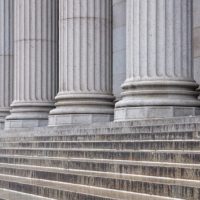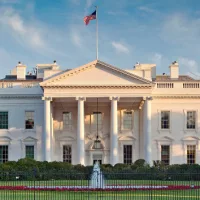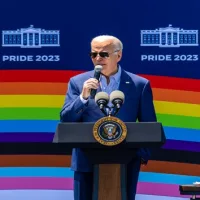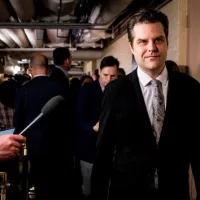
iStock/Rawf8BY: BEN GITTLESON and JORDYN PHELPS
(WASHINGTON) — While the nation lost a judicial icon with the passing of Supreme Court Justice Ruth Bader Ginsburg over the weekend, President Donald Trump won a monumental political opportunity in the form of a vacancy on the nation’s highest court with the potential to cement its conservative majority.
Coming just six weeks before Election Day, as the nation crept toward the devastating milestone of 200,000 lives lost and the president lagging in polls behind his Democratic opponent, former Vice President Joe Biden, the vacancy has fundamentally altered the race.
The opening immediately provided Trump with a welcome diversion from what until now has been a race largely framed as a referendum on his handling of the coronavirus pandemic. It had the potential to fire up both Republicans and Democrats, though, and the true electoral impact remained to be seen.
Asked on Fox News Monday whether politics comes into play as he makes his decision, the president acknowledged that politics are an unavoidable element of the calculation.
“I try not to say so. I think probably automatically it is. Even if you’re not wanting to do that it becomes a little automatic,” the president said.
President Trump offered a nod to the fact that one of the candidates on his short-list, Barbara Lagoa, is from the must-win state of Florida.
“She’s an extraordinary person. I’ve heard incredible things about her. I don’t know her. She’s Hispanic and highly respected. Miami. Highly respected,” Trump said of Logoa, a Cuban American federal judge from Florida.
A Fox anchor pointed out that Lago could help Trump politically in Florida, a battleground with a large Cuban American population.
“She’s a terrific woman, from everything I know,” the president said. “I don’t know her. Florida, we love Florida. So she’s got a lot of things – very smart.”
Asked if politics would play a role in his selection, Trump replied: “I try not to say so. I think probably automatically it is, even if you’re not wanting to do that, it becomes a little automatic.”
Even prior to Ginsburg’s death Friday, the president had sought to make the Supreme Court a central issue in his case for reelection, having previously used the tactic successfully in 2016 to bring along conservative voters who were otherwise disinclined to support his unorthodox candidacy.
Just nine days before Ginsburg’s passing, he had released an expanded list of conservative legal minds he vowed to choose from in the event of a future vacancy.
And even as he offered his condolences and words of admiration for the late justice, he lost no time in signaling his intentions to move forward with due haste to fill her seat, announcing on Saturday that he would nominate a woman to replace Ginsburg.
By Saturday night, the issue had already become a rallying cry for his base, with supporters at a Trump campaign rally in North Carolina chanting, “Fill that seat!” His campaign then emblazoned the phrase upon campaign memorabilia.
Earlier this year, Biden had pledged to nominate a Black woman to the court if he won the White House and said he was working on a list of prospective nominees. Biden has resisted pressure to release his list publicly, declining to do so before the election.
Trump’s announcement that he would choose from among a list of women finalists came after the president and his allies pounded Biden earlier this year for vowing to make a female pick for vice president. “Some people would say that men are insulted by that,” Trump said last month.
Supreme Court confirmation processes in the current political era have become extremely political affairs, and Trump himself had turned outwardly partisan within hours of Ginsburg’s death.
At a campaign rally in North Carolina the evening after she passed away, the president led his supporters in what he called a “poll” of cheers about whether he should choose a man or a woman to replace the late justice. He rejoiced in their chants of, “Fill that seat!”
Earlier that day, his campaign had sent emails and text messages to supporters raising money off the court vacancy.
It remained to be seen which party would benefit more at the polls on Nov. 3.
Both Republicans and Democrats saw potential for the focus on the Supreme Court to energize their bases and turn out voters.
On Saturday, and again Monday morning, Trump said he wanted a confirmation vote by the election. But the timing was technically out of his hands, instead controlled by Senate Majority Leader Mitch McConnell — and several GOP senators who, together, could slow the process.
McConnell over the course of Trump’s term has made confirming conservative federal judges a top priority, after years of slowing and blocking then-President Barack Obama’s nominations. On the campaign trail, Trump frequently touts the relatively large number of the federal judges who have been confirmed during his tenure.
McConnell and the White House often work in lockstep, and on Sunday, the vice president’s chief of staff, Marc Short, told CNN that the White House would “leave the timetable to Leader McConnell.”
But in this nomination fight, two Republican senators, Sen. Lisa Murkowski, of Alaska, and Sen. Susan Collins, of Maine, have already bucked the Senate majority leader’s goal of moving at a breakneck pace.
They have both said they do not want a confirmation vote before Nov. 3, and Collins said she thought whichever presidential candidate won should fill the seat.
Trump wasted no time taking public shots at them, tweeting about Murkowski and mentioning Collins at the North Carolina rally.
Meanwhile, Sen. Cory Gardner, who represents a more split electorate of Colorado and is up for election this year, has yet to express a position. On Monday, Trump publicly tried to sway him.
“I think it’s going to help Cory Gardner,” the president said during his interview with Fox News. “He’s a great guy, by the way, and a– very, very loyal to the party and loyal to his state.”
Question marks also hovered above Sen. Mitt Romney, of Utah, and Sen. Chuck Grassley, of Iowa.
Romney has repeatedly demonstrated his independence from the president in the Senate and most notably, was the only Republican to vote to remove Trump from office earlier this year.
Grassley, who previously chaired the Senate Judiciary Committee, told reporters in July that if it were up to him, he would not hold a hearing on a vacancy in this election year because Republicans had used the same logic to block an Obama nominee in 2016.
Copyright © 2020, ABC Audio. All rights reserved.















